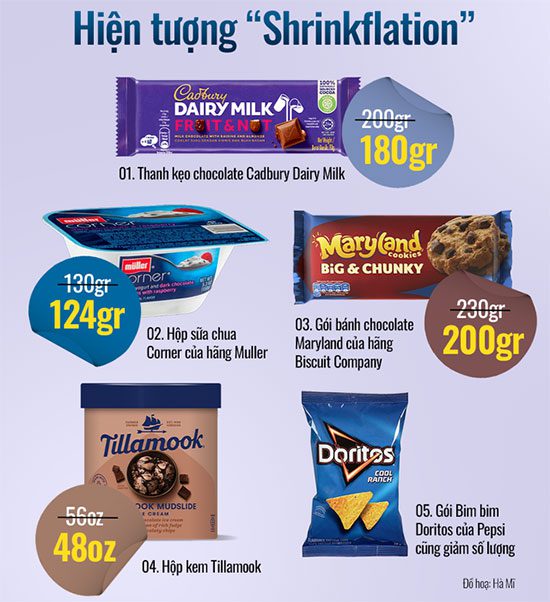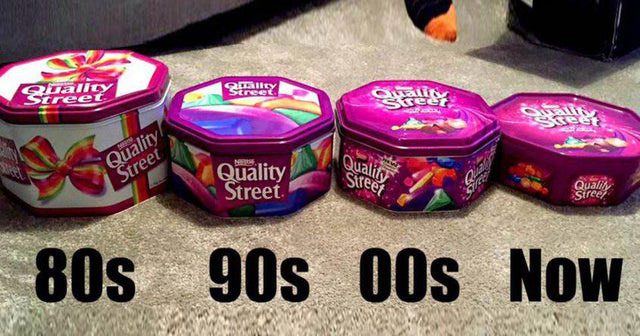In today’s era of inflation, it is well-known that many products have increased in price. However, few people pay attention to the fact that the quantity of the items they purchase has decreased, or even the quality.
In reality, many items today, from chocolate bars to snack packages, soup boxes, sausages, or dishwashing liquids, have undergone slight changes in size, especially in the food sector.
For example, Cadbury Dairy Milk chocolate bars have decreased from 200 grams to 180 grams, Muller’s Corner yogurt has reduced from 130 grams to 124 grams, and the Maryland chocolate biscuit package from Biscuit Company has gone from 230 grams to 200 grams.

Tillamook ice cream boxes have reduced in weight from 56 oz to 48 oz, while Pepsi’s Doritos snack packages have also decreased in quantity, and Domino’s Pizza has cut down on the number of chicken wings in their takeout combo meals.
This phenomenon of reducing product units is referred to by economists as “Shrinkflation”, where items are downsized in size or quantity, or sometimes even have their formulas changed, diminishing quality while the item’s price remains the same or even increases.
The main reason is that companies are forced to cut product units, selling less per item to maintain prices, thus avoiding losing sales during inflationary times while maintaining their brand image.
While many supermarket chains in the U.S., like Costco, have kept the price of rotisserie chicken stable over the past decade in exchange for raising prices on other items, many brands cannot do the same.
Widespread
The term “Shrinkflation” first appeared in 1969 when journalist Arthur Buchwald wrote satirical commentary on inflation. The term began to gain widespread recognition in the 1970s when a multitude of manufacturers sought to protect their profit margins in the face of rising costs and slowing growth, leading them to devise new tricks.
Today, the practice of reducing product units is nothing new; however, due to the minor reductions, they do not attract consumers’ attention. Bloomberg reports that this situation is occurring everywhere in the world, from Australia to India, from the UK to the US.
In the UK, the story of Shrinkflation emerged after the country’s citizens voted to leave the European Union (EU), known as Brexit. Mondelez International reduced the weight of its Toblerone chocolate bar but had to revert to the original size after consumer backlash.

Manufacturers are very cautious in reducing product units.
According to Bloomberg, to make it harder for consumers to notice, manufacturers are very cautious in reducing product units. They may keep the size the same but slightly reduce the weight, making customers unaware that they are buying less for the same amount of money.
In agreement, the online retailer Britsuperstore, using analysis data from “Money Saving Expert,” reported that people in the UK are complaining significantly about chocolate, followed by cheese and milk, as product sizes change and no longer match previous standards.
Despair
Bloomberg states that with the current inflation situation, consumers will not be able to do much if they wish to continue buying goods at old prices. They will have to accept that product quality will not be the same as before or be prepared to spend more money.
According to Bloomberg, this reduction in product units often occurs with major brands to maintain their reputation; thus, customers might try looking for less well-known labels. At the very least, smaller brands may raise their prices rather than incur additional costs from changing unit sizes to maintain their image.
On the company side, many explanations have been offered for this action. Some justify that customers are still willing to buy less if the price remains unchanged, while others argue that they are protecting consumer health with lower sugar products or safeguarding the environment…
For Mondelez, this is the first time in ten years that they have to reduce the size of the Dairy Milk chocolate bar to remain competitive and ensure sales against rivals as costs rise due to inflation.
Meanwhile, a Shopmate survey found that 50% of retailers in the UK believe that the best brands are reducing sizes rather than increasing prices because customers are very sensitive to prices, and this significantly impacts sales.





















































